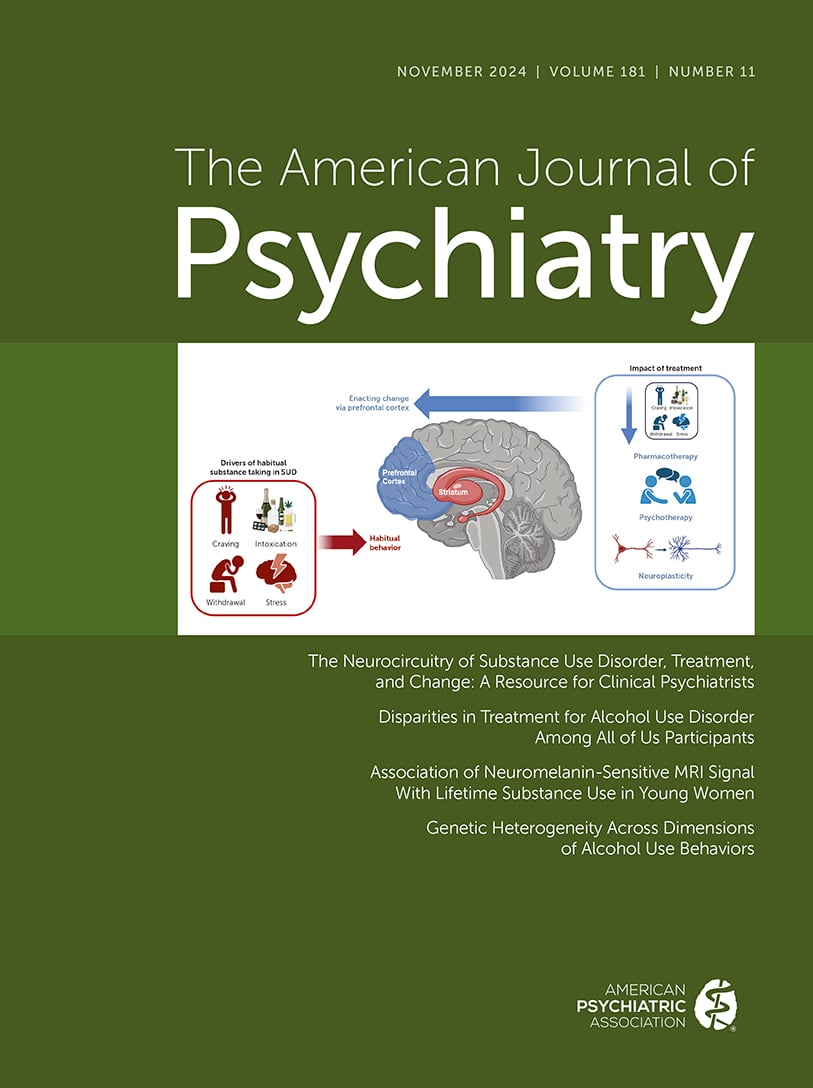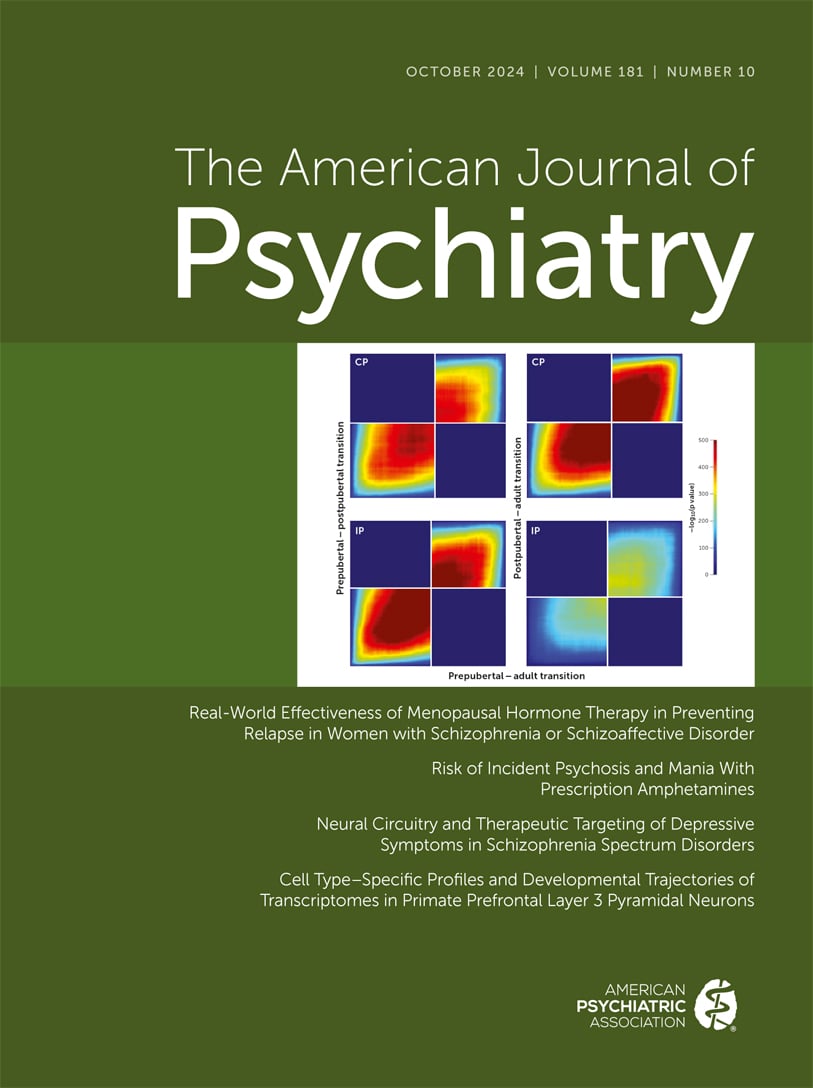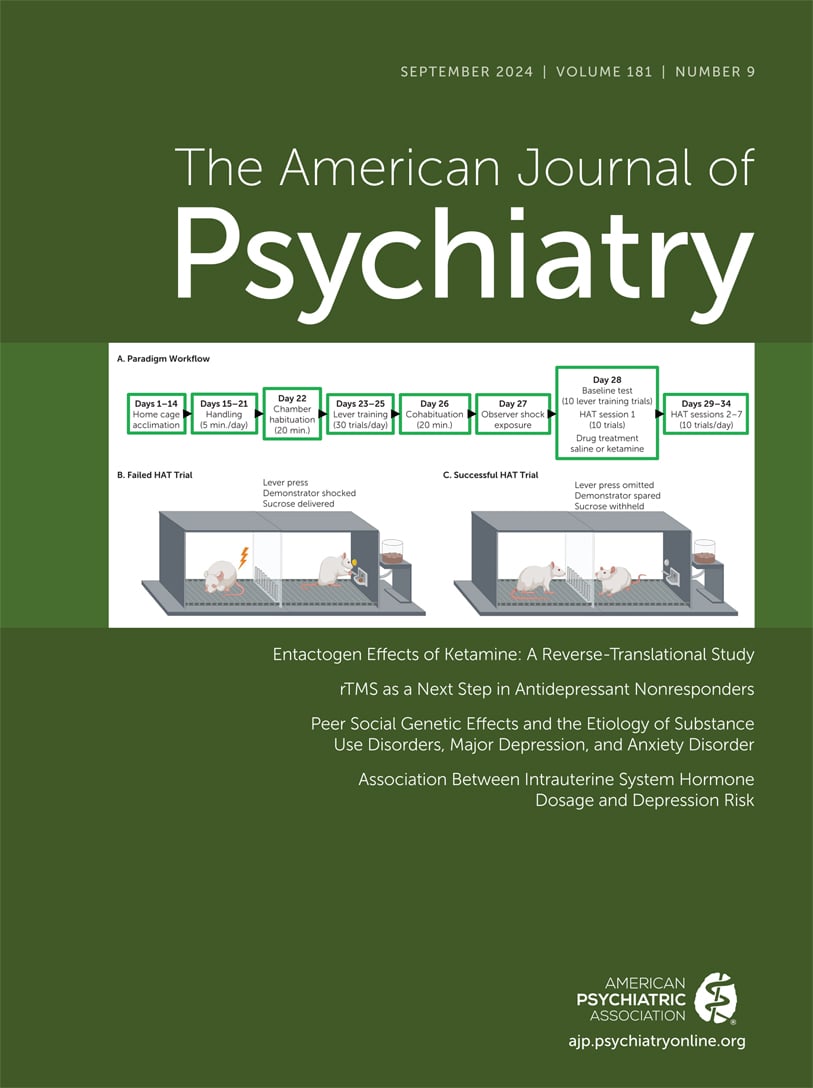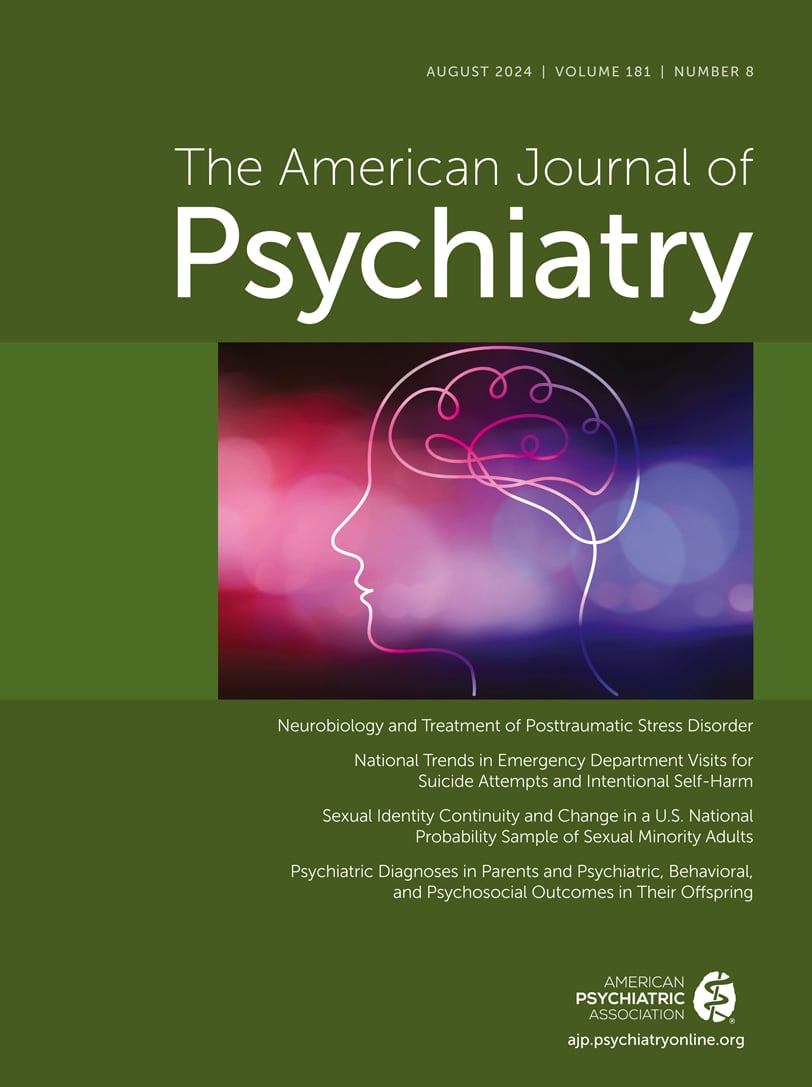American Journal of Psychiatry
- Volume 163
- Number 2
- February 2006
In This Issue
Editorials
Editor's Note
Reviews and Overviews
Publication date: 01 February 2006
Pages185–194OBJECTIVE: In many parts of the world, second-generation antipsychotics have largely replaced typical antipsychotics as the treatment of choice for schizophrenia. Consequently, trials comparing two drugs of this class—so-called head-to-head studies—are ...
https://doi.org/10.1176/appi.ajp.163.2.185Introspections
Treatment in Psychiatry
Clinical Case Conference
Images in Psychiatry
Article
Publication date: 01 February 2006
Pages210–216OBJECTIVE: Clinicians have few evidence-based options for the management of treatment-resistant bipolar depression. This study represents the first randomized trial of competing options for treatment-resistant bipolar depression and assesses the ...
https://doi.org/10.1176/appi.ajp.163.2.210Publication date: 01 February 2006
Pages217–224OBJECTIVE: Little is known about clinical features associated with the risk of recurrence in patients with bipolar disorder receiving treatment according to contemporary practice guidelines. The authors looked for the features associated with risk of ...
https://doi.org/10.1176/appi.ajp.163.2.217Clinical Features of Bipolar Depression Versus Major Depressive Disorder in Large Multicenter Trials
Publication date: 01 February 2006
Pages225–231OBJECTIVE: Failure to recognize bipolar disorder in patients who experience a major depressive episode may lead to inappropriate treatment and poorer outcomes. Clinical features that could distinguish bipolar from unipolar depression would facilitate more ...
https://doi.org/10.1176/appi.ajp.163.2.225Publication date: 01 February 2006
Pages232–239OBJECTIVE: The authors examined the comparative risks of switches in mood polarity into hypomania or mania during acute and continuation trials of adjunctive antidepressant treatment of bipolar depression. METHOD: One hundred fifty-nine patients with ...
https://doi.org/10.1176/appi.ajp.163.2.232Publication date: 01 February 2006
Pages240–246OBJECTIVE: To assess whether age at onset variation reflects underlying genetic heterogeneity in bipolar disorder, the authors examined the clinical and familial characteristics of age at onset in bipolar disorder subjects from families with multiple ...
https://doi.org/10.1176/appi.ajp.163.2.240Publication date: 01 February 2006
Pages247–256OBJECTIVE: In a placebo-controlled, double-blind study, the authors investigated the efficacy and safety of olanzapine as monotherapy in relapse prevention in bipolar I disorder. METHOD: Patients achieving symptomatic remission from a manic or mixed ...
https://doi.org/10.1176/appi.ajp.163.2.247Publication date: 01 February 2006
Pages257–264OBJECTIVE: The authors previously identified depression-specific differences in brain responses to an emotional challenge in patients with bipolar and unipolar mood disorder. In this study, potential markers of bipolar risk and resilience were examined in ...
https://doi.org/10.1176/appi.ajp.163.2.257Publication date: 01 February 2006
Pages265–271OBJECTIVE: This study tested whether behavioral disinhibition is more prevalent among offspring of parents with bipolar disorder than among offspring of parents without bipolar disorder. METHOD: The authors conducted a secondary analysis of data from a ...
https://doi.org/10.1176/appi.ajp.163.2.265Publication date: 01 February 2006
Pages272–275OBJECTIVE: Several studies have shown that achieving adequate serum valproate levels is critical to rapid stabilization of acute mania, but estimates of the target therapeutic level have been imprecise. A post hoc analysis of pooled intent-to-treat data ...
https://doi.org/10.1176/appi.ajp.163.2.272Publication date: 01 February 2006
Pages276–285OBJECTIVE: Shape differences in the caudate heads and putamen were compared between drug-naive and drug-treated patients with bipolar disorder and healthy comparison subjects by using spherical harmonic (SPHARM) techniques. On the basis of previous ...
https://doi.org/10.1176/appi.ajp.163.2.276Publication date: 01 February 2006
Pages286–293OBJECTIVE: A systematic evaluation of neuropsychological functioning in individuals with pediatric bipolar disorder is necessary to clarify the types of cognitive deficits that are associated with acutely ill and euthymic phases of the disorder and the ...
https://doi.org/10.1176/appi.ajp.163.2.286Publication date: 01 February 2006
Pages294–296OBJECTIVE: Sibling recurrence risk in autism has been estimated to be approximately 10%. This study investigated subsyndromal autistic impairments among siblings of probands with pervasive developmental disorders. METHOD: The authors used the Social ...
https://doi.org/10.1176/appi.ajp.163.2.294Publication date: 01 February 2006
Pages297–302OBJECTIVE: Pathological gambling is described in DSM-IV as a chronic and persisting disorder, but recent community-based longitudinal studies that have highlighted the transitory nature of gambling-related problems have called into question whether this ...
https://doi.org/10.1176/appi.ajp.163.2.297Publication date: 01 February 2006
Pages303–312OBJECTIVE: Pathological gambling is a disabling disorder experienced by approximately 1%–2% of adults and for which there are few empirically validated treatments. The authors examined the efficacy and tolerability of the opioid antagonist nalmefene in ...
https://doi.org/10.1176/appi.ajp.163.2.303Brief Report
Publication date: 01 February 2006
Pages313–315OBJECTIVES: The authors compared the switch rate into hypomania/mania in depressed patients treated with second-generation antidepressants who had either bipolar I or bipolar II disorder. METHOD: In a 10-week trial, 184 outpatients with bipolar depression ...
https://doi.org/10.1176/appi.ajp.163.2.313Publication date: 01 February 2006
Pages316–318OBJECTIVE: The authors’ goal was to investigate phosphatidylinositol and glutamatergic metabolism in the anterior cingulate cortex of children and adolescents with attention deficit hyperactivity disorder (ADHD) alone, children with ADHD plus bipolar ...
https://doi.org/10.1176/appi.ajp.163.2.316Publication date: 01 February 2006
Pages319–321OBJECTIVE: This study sought to determine psychiatric comorbidity among elderly individuals with bipolar disorder. METHOD: An epidemiological community survey identified 84 elderly (ages ≥65) respondents with bipolar disorder, 1,327 younger adults with ...
https://doi.org/10.1176/appi.ajp.163.2.319Publication date: 01 February 2006
Pages322–324OBJECTIVE: Previous diffusion tensor imaging findings have supported suggestions that bipolar disorder is characterized by subtle white matter changes. The chronic nature of the study population, however, has limited interpretation of these findings. In ...
https://doi.org/10.1176/appi.ajp.163.2.322Letter to the Editor
Correction
Book Forum
Books Received
APA Official Actions
Past Issues
View Issues Archive
Vol. 181 | No. 11

Vol. 181 | No. 10

Vol. 181 | No. 9
